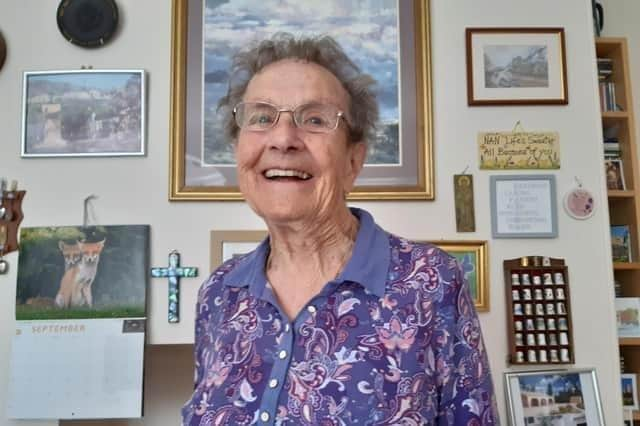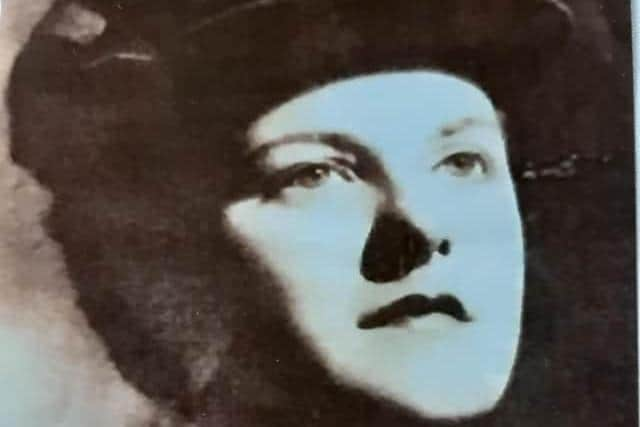Yorkshire World War Two veteran shares her memories of driving ambulances and meeting Queen Elizabeth II
98-year-old Sheila Pantin's war would see her become one of the first women to enter Belsen after the concentration camp was liberated in April 1945.
Later she would become a teacher, before returning to military service and serving in places like Northern Ireland during the Troubles. But it was as a teenager recruit in the Auxiliary Territorial Service (ATS), the women's branch of the British Army, that she met the late Queen Elizabeth II.
Advertisement
Hide AdAdvertisement
Hide Ad"It was terrible to hear the news of Her Majesty’s death,” remembers Sheila, who lives on Springfield Avenue in Harrogate and will be 99 next month.


"I met Corporal Princess Elizabeth, as she was known then, during the war when she was in the ATS, too, and an army ambulance driver like me.
"It’s been a bad week. It is so sad she has gone.”
After being called up in August 1941 at the age of 17, Sheila trained to be a driver of army ambulances and staff cars.
Such was the pioneering nature of her role, however, she soon found herself recruited as one of the 'poster girls' for the service. For almost a whole year in 1941-42, Sheila was part of a touring party of 30 Auxiliary Territorial Service members who travelled the length and breadth of the UK to drum up support from the public at a time when attitudes towards women and their role in society were very different to now.
Advertisement
Hide AdAdvertisement
Hide Ad

It was at one of the public events in community halls and theatres that she met the future monarch.
"The tour went as far as Glasgow,” said Sheila, who is still in robust health both physically and mentally.
"The point was to show ATS service members such as myself and my comrades were decent honourable women doing a job of work.
"There was a lovely feeling between all of us, though. We enjoyed going round the country talking about our work.
Advertisement
Hide AdAdvertisement
Hide Ad"The Yorkshire Post came and interviewed us once during the war and my picture ended up in the paper.
"One of the events was in the Royal Albert Hall. I saw Princess Elizabeth was there in one of the boxes.
"When it finished, she came downstairs to our room and thanked us. She said she’d really enjoyed watching us.”
Sheila, who is shortly to be guest of honour at a screening at the Harrogate Odeon of Harrogate On Film, a new documentary of vintage footage of the town and its people, said she had fallen into being a driver because of her father.
Advertisement
Hide AdAdvertisement
Hide AdBorn in Gargrave near Skipton, her mother died in childbirth when she was four years old.
She was brought up by her father who had served in World War One before running a bus company, then moving to Leeds.
Sheila won a scholarship to Leeds Girls’ High School aged 11, and went on to became one of the first women to earn her public service vehicle licence – or PSV.
"When I got my call-up papers I was too young to join the military so my father had to sign them for me. I told the ATS I could drive when I joined but the reason I could drive was because my father had taught me.”
Advertisement
Hide AdAdvertisement
Hide AdA quick learner from the start, Sheila was quickly made a corporal and, then, after taking additional training to be an expert physical training instructor or PTI, she was made a sergeant.
This rapid rise up the ranks saw her being billeted in different barracks in a wide variety of places in the UK from London to Edinburgh.
But, after seeing most of Britain in relative safety, Sheila was posted abroad after D-Day in the autumn of 1944.
"I was taken across the Channel over to France by boat,” she said.
Advertisement
Hide AdAdvertisement
Hide Ad"It was a very hazardous journey. Twice we had to turn off all our engines and lights because there were German U-boats in the area.
"Once we landed, it was most peculiar going along the minor roads cluttered with tanks and lorries.”
As the Allies pushed across the continent towards Germany, through France, Belgium and Holland, Sheila’s innate intelligence, resilience and versatility saw her called upon to do her bit for the war effort in a range of ways beyond driving army ambulances and driving staff cars for the officers.
There were still moments, however, when the culture of the era as regards the female sex was thrown into sharp relief.
Advertisement
Hide AdAdvertisement
Hide Ad"I was sent to report for duty at 8am sharp one morning. The office was full of officers, from captains to colonels. There were flashes of red everywhere.
"I saluted and there was just silence. They were surprised to see me.
"Because Sheila wasn’t my first name I think they were expecting me to be a man. I’m not sure they had realised there were any women in the army."
At one point during the British army’s long march across Europe to liberate the continent from Nazi Germany, Sheila ran a centre for traumatised women at Waterloo in Belgium.
Advertisement
Hide AdAdvertisement
Hide AdOn another occasion in Eindhoven in Holland, she would be asked to provide her PE skills for the troops.
Such is the haphazard nature of warfare, when Sheila was finally posted to Germany in the final months of the war, she had no idea what was coming.
War over, job done, she spent VE Day in Brussels where life was normal enough to enjoy the celebrations.
In 1946 Sheila was finally demobbed. After being taken by boat to Dover, then by troop train to York, she was a civilian once again, if a little older and worldly-wise.
Advertisement
Hide AdAdvertisement
Hide AdShe took up teaching in maths and PE in Castleford and got married. When her husband died at a young age in 1969, Sheila retired from teaching, remarried and raised a family. But she felt the call of military service pulling her back.
Sheila volunteered to be a welfare officer in the WRVS, which delivers an independent and confidential support to service personnel at military bases in the UK and abroad.
Her second spell in the cause of Britain’s army saw her posted to the Cold War in Germany, the Troubles in Northern Ireland, the British military base in Belize and, even the Gurkhas in Hong Kong.
Having moved in the early 1980s to Harrogate to work at the Army Apprentices College, Sheila finally retired for good in 1984.
Advertisement
Hide AdAdvertisement
Hide AdBut, 77 years since the war ended, Sheila remains as bright as a button, as sharp as a knife.
And her memories of that time, of her meeting with the Queen and her adventures across Britain and the Continent in the service of her country remain vivid and true.
In particular, she will never forget Belsen.
"I had been asked to lead a convoy of about ten three-tonne Bedford lorries into Germany from Holland. I thought it would be something to do with creating a PTI training centre for British troops. When I got there I was asked if I wanted to work in the camps.
"I thought they meant barracks but it turned out they didn’t mean that at all. There was the camp with this huge entrance and an awful lot of huts surrounded by barbed wire fencing. It was Belsen.
Advertisement
Hide AdAdvertisement
Hide Ad"I could see our boys digging out mass graves to give the bodies proper burials. The only people left alive were in rags and were in a terrible state.
"They didn’t even know how to eat.”
It was Sheila Pantin’s job to look after the ravaged survivors in the camp, to clean them, dress them, show them how to use a knife and fork, to try to restore a little humanity after the horrors of the Nazi Holocaust.
Which she is exactly what she did.